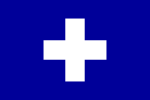In antiquity Ikaria was known as Icarus and the sea (Ikarian Pelagos) around it was described by Homer as one of the most turbulent seas in the East Aegean. Exposed by its location to the strong Etesian (Meltemi) northerly winds during the summer months, the Ikarian Sea could be and still is often particularly choppy.
Archaeologists believe that Ikaria has been inhabited for at least the last 9,000 years, with pre-Greek inhabitants known as Pelasgians living there until around 2,000 BC when Carians also arrived from elsewhere in the Aegian. The Greeks arrived in the Aegian in around 1,500BC, and within 300 years held most of the Aegian islands. As Ikaria does not have many natural ports, and it has an rugged unbroken coastline, it is unlikely that the Greeks settled Ikaria at that time. Since it also had very little arable land, and was covered in dense forests, it would not have been an easy place to live. Finally in around 800-700BC Greeks from Miletus settled in Therma and Campos (then called Oenoe), probably just as stopping points for Milesian boats travelling to their colonies further north.
In around 600BC Ikaria found itself annexed into the empire of Polycrates together with its neighbour Samos. It is believed that at around this time the famous temple of Artemis was built at Nas (in the NE of Ikaria). It was to this temple, built on a sacred spot of the original pre-Greek inhabitants, that sailors about to set sail in the dangerous Ikarian Sea would make sacrifices to Artemis, the patron saint of sailors.
For a few decades around 500BC, Ikaria fell to the Persians, but then Ikaria joined the Delian League (an association of Greek city-states who fought the Persians under the leadership of Athens) and became well known for its Pramnian Wine. Around this time there were around 13,000 inhabitants on Ikaria (compared to just 8,000 today). During the Peloponnesian War from 431-404 BC prosperity fell in Ikaria and did not really improve until Ikaria joined the Second Athenian League in 387BC.
After a couple of centuries of steady decline, the Roman Emperor Philip V (221-178 BC) raided the Aegean islands including Ikaria. It was not however until 129 BC that Samos was incorporated by the Romans into their province of Asia, together with Ikaria. As the Romans had more important things to attend to, Ikaria neglected, raided by pirates repeatedly, and by the start of the new millennium was essentially a deserted island used only by farmers from Samos to hold their herds of animals.
In another 500 years, at the end of the fifth century AD, Ikaria entered the Byzantine Empire where it remained for almost 700 years. When Byzantium fell, Ikaria came under Constantinople. In the 14th century, the island of Chios was taken by the Genoese and Ikaria became part of their empire. In order to avoid being looted, Ikarians did not build villages at this time. Instead individual houses were built remote from its neighbours and with only one door, no chimney (since smoke would give away the location of the house), and no possessions except for those hidden in niches in the walls.
When the Turks overcame the Genoese, Ikaria was first controlled by the Knights of St. John based in Rhodes, until 1521 when Ikaria was finally conquered and became part of the Ottoman empire. Ikaria was pretty much ignored by the Turks and it became very poor.
In 1827 Ikaria attempted to escape the grip of the Ottoman Empire, but was shortly after put back under Turkish control. It was not until July 1912 that Ikaria became independent after expelling the Turkish garrison posted there and establishing the Free State of Ikaria. It had its own national anthem, flag (pictured above), stamps, and armed forces. Ikaria finally joined the new free Greek state in November 1912 having struggled alone for five months with limited food and communications with the outside world.
Until the 1960′s life on Ikaria remained very hard. The Greek government did nothing to help develop Ikaria, and so the population looked to Ikarians who had left to seek their fortune in USA to send remittances back to help develop schools, medical facilities, roads, and so on. Things only got worse during the Second World War when the island was occupied by the Germans and the Italians and hundreds starved to death. With the inhabitants sympathetic to Communism, the Greek goverment exiled 13,000 communists to Ikaria from the end of WWII through the Greek Civil War to 1949.
Finally in the 1960′s the Greek goverment invested heavily in Ikaria to improve its roads and services, and helped to promote the island as a tourist destination.
